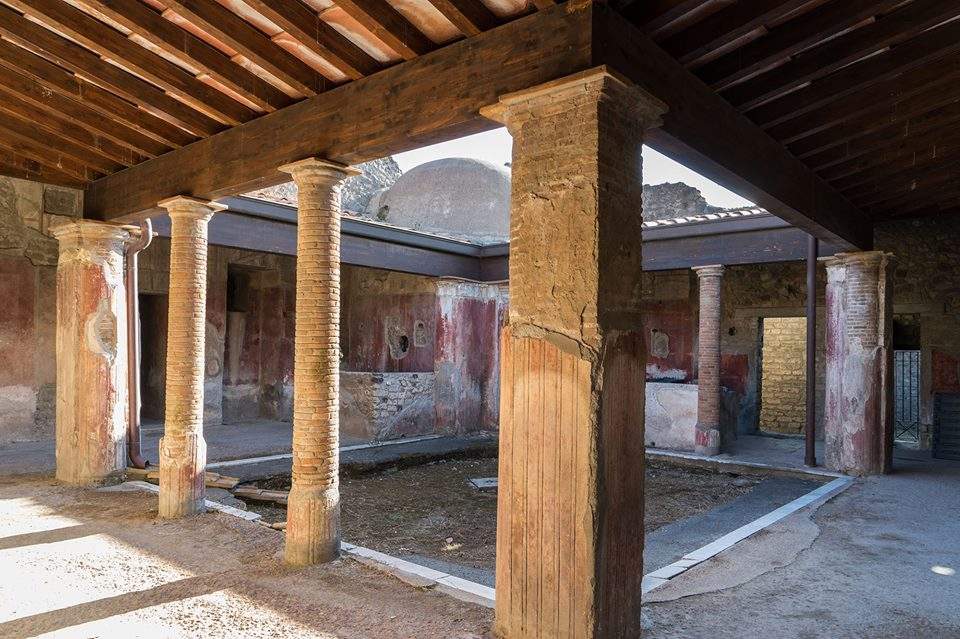As of today, November 1, 2018, two important residences in Pompeii are reopening to the public: these are the House of the Ceii, known for the paintings on the garden walls depicting Egyptian-inspired scenes and wild animals, and the Praedia of Julia Felix, a large residential complex with extensive green spaces, rich decorations, and luxurious private bath quarter.
The Domus dei Ceii had been closed for several years, while the Praedia di Giulia Felice had been partially reopened after the restoration of the decorative apparatuses carried out between 2015 and 2016 as part of the Great Pompeii Project. The two complexes have, recently, undergone upgrading, stormwater regimentation and roof maintenance, which were necessary due to a progressive loss of functionality of the roofs themselves. This loss of functionality was exposing to a serious risk of degradation the rooms below, which are characterized by ornate plasterwork and valuable floors. The interventions carried out are part of the “Italy for Pompeii” project financed with European Community funds POR-FESR 2007 -2013, which had already affected other houses in Regiones I and II, including the Domus del Larario Fiorito and the Domus del Triclinio all’aperto, reopened last year.
Thus, the large hunting scene with wild animals that adorns the back wall of the garden of the House of the Ceii is once again visible, in addition to the Egyptian landscapes populated with Pygmies and animals typical of the Nile Delta depicted on the adjacent side walls. These are subjects that often recur in the decoration of the perimeter walls of Pompeian gardens, in order to illusionistically expand the dimensions of the spaces and evoke within them an idyllic and evocative atmosphere. In this case, in all likelihood, the theme of the paintings also testified to a specific connection and interest that the owner of the domus had for the Egyptian world and the cult of Isis, which was particularly widespread in Pompeii in the last years of the city’s life. The large fresco will soon be the subject of a specific restoration, which will be carried out “on sight” of the public.
Ownership of the domus was attributed to the magistrate Lucius Ceius Secundus, based on an electoral inscription painted on the exterior elevation of the house. The façade of the domus, with its white stucco panelling and tall portal crowned with cubic capitals, exemplifies the severe appearance that a mid-level house of the late Samnite period (2nd cent. BCE) must have had. In the center of the tetrastyle atrium peculiar is the impluvium basin, made with fragments of amphorae placed in a cut, according to a technique widespread in Greece but which Pompeii finds only one other comparison in the house of the Ancient Hunt. In the house, part of the original layout of the dwelling will be repurposed, with the relocation of the marble table and the well vera in the atrium, where the cast of a cupboard and the cast of the house’s entrance door are also visible. While a small domestic millstone is visible in the kitchen.
In contrast, the large complex of the Praedia of Julia Felix, which arose at the end of the first century B.C. from the amalgamation of pre-existing buildings, looks like a kind of “urban villa,” provided with large green spaces and divided into four different nuclei with independent entrances: an atrium house, a large garden onto which the residential rooms open, a richly decorated bath quarter and a vast park. The complex owes its name to an inscription painted on the facade (now preserved at the National Archaeological Museum in Naples), in which the last owner, Giulia Felice, after the disastrous earthquake of 62 AD, announced the lease of part of her property. To the post-earthquake period dates a unified decorative renovation that affected most of the rooms, among which stands out the summer triclinium (dining room), lined like a grotto, with water features around the convivial beds and open to the portico punctuated by marble pillars. The garden equipped with a central euripus (long canal) recreated in its original arrangement an idyllic-sacral space. The house, excavated and then covered over at the end of Bourbon-era explorations, was entirely brought to light in the 1950s.
The two dwellings can be visited as part of the Pompeii Archaeological Site tour, which opens daily from 9 a.m. to 5 p.m. (last entry at 3:30 p.m.); Saturday and Sunday open at 8:30 a.m.
 |
| Pompeii, the House of the Ceii and the complex of Julia Felix reopen to the public |
Warning: the translation into English of the original Italian article was created using automatic tools. We undertake to review all articles, but we do not guarantee the total absence of inaccuracies in the translation due to the program. You can find the original by clicking on the ITA button. If you find any mistake,please contact us.